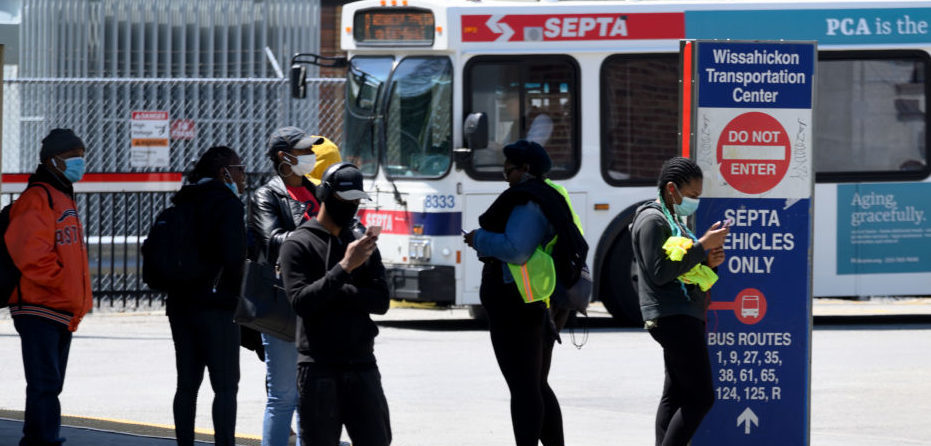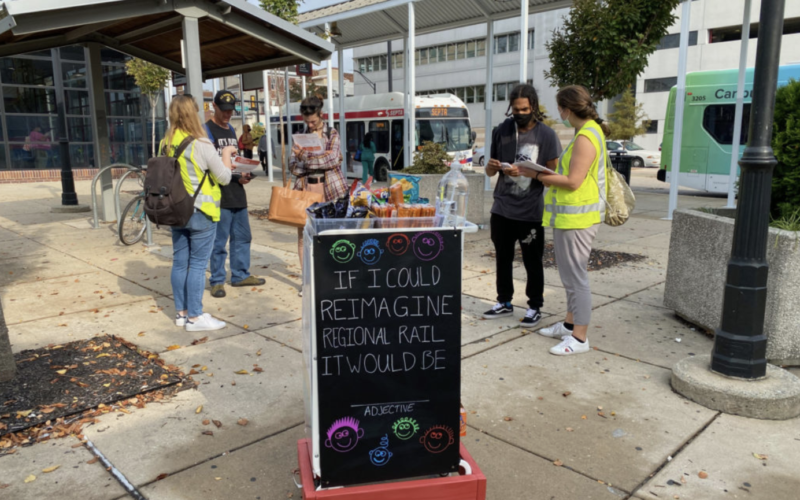
Riders wait for a bus in Philadelphia, PA.
Millions of people across the country are at risk of losing access to good transit as the COVID pandemic grinds on and imposes an unprecedented fiscal crisis on the nation’s transit agencies.
The pandemic has eroded the revenue streams that pay for transit, while emergency funding from the federal CARES Act, enacted in March, has been nearly exhausted in major cities. In many places, transit is now at a financial breaking point. Without more emergency aid, transit leaders in cities like New York and Denver are warning of 40% service cuts.
What would cuts of this magnitude mean for riders? To find out, TransitCenter and the Center for Neighborhood Technology (CNT) estimated the effect of service cuts in 10 regions – Chicago, Atlanta, Boston, Denver, Miami, Cincinnati, New York, Philadelphia, Seattle, and Los Angeles.
The analysis conveys the catastrophic results of severe service cuts. In the 10 regions we modeled alone, more than 3 million people and 1.4 million jobs would lose access to frequent transit. The results are summarized in our new report, “Stranded.”
The effects of service cuts were modeled with AllTransit, a CNT analysis tool that combines Census and public transit data. We modeled a 50% service cut to peak service and a 30% cut to off-peak service, reflecting the likelihood that cuts would attempt to preserve some full-day service. (The analysis is based on the potential impacts of budget shortfalls – not specific transit agency proposals.)
Black and Hispanic residents rely on transit the most and would be hardest-hit. In Atlanta, for example, more than half of residents losing access to frequent all-day service would be Black. Three-quarters of the Miami residents who would lose access to good service identify as non-white.
Second- and third-shift workers would lose an affordable way to commute. In Philadelphia, 21,948 commuters who commute between midnight and 5 a.m. would lose access to frequent transit.
Throughout the country, households without vehicles would struggle to access jobs, groceries, and healthcare. In Seattle, 16,791 households that don’t own a car would lose access to frequent transit, imperiling their ability to meet essential needs.
Deep transit cuts would affect riders like Patrick Jones, who currently rides two buses to get from his home in Cincinnati to reach his job as a forklift operator across the river in Covington, KY. An essential worker, Jones relied on transit throughout the depths of the pandemic. Already, his typical commute has slowed by 10-20 minutes, as service changes lengthen the wait to transfer between buses in downtown Cincinnati. His trip to work now takes up to an hour and a half.
Cuts would force riders like Ayanna Wright, who rides the bus from her home in Miami Gardens to her late shift at a restaurant, to spend money she doesn’t have on costly taxi rides. The night owl bus service she depended on has been suspended, and she’s now forced to pay for an Uber multiple times per week. “God forbid I have to be at work at midnight – that means I have to leave my house at 10 pm to be at work,” she said. “If public transit were cut further, that would be even more time and money out of my pocket, and I can’t afford it.”
And cuts would dramatically limit the ability of disabled riders like Anna Zivarts of Seattle to fully participate in her community. Anna is a low-vision mom, who has never been able to get a driver’s license. Like many disabled and transit-dependent people, Anna has always tried to arrange her life to be close to reliable transit – where she lives, where she works, where she takes her kid to preschool or the doctor. Cuts would cause major disruptions to her family’s life.
The sheer scale of the transit cuts being proposed will dwarf the service cuts experienced during the 2008 recession, and will make it much more difficult for American cities to recover from COVID. These cuts will imperil the ability of essential workers to reach their jobs, and for businesses to find employees that have an affordable, reliable way to get to work. And they will leave riders like Patrick, Ayanna, and Anna stranded.
To learn how the cuts might impact your city, visit the individual fact sheets for Chicago, Atlanta, Boston, Denver, Miami, Cincinnati, New York, Philadelphia, Seattle, and Los Angeles.
 New TransitCenter Report: To Solve Workforce Challenges Once and For All, Transit Agencies Must Put People First
New TransitCenter Report: To Solve Workforce Challenges Once and For All, Transit Agencies Must Put People First
TransitCenter’s new report, “People First” examines the current challenges facing public sector human resources that limit hiring and retention, and outlines potential solutions to rethink this critical agency function.
Read More A Transit Revolution in Philadelphia?
A Transit Revolution in Philadelphia?
The Southeastern Pennsylvania Transportation Authority (SEPTA) has been working throughout the pandemic on several system-wide planning initiatives that have the potential to transform transit service in and around the city of Philadelphia.
Read More